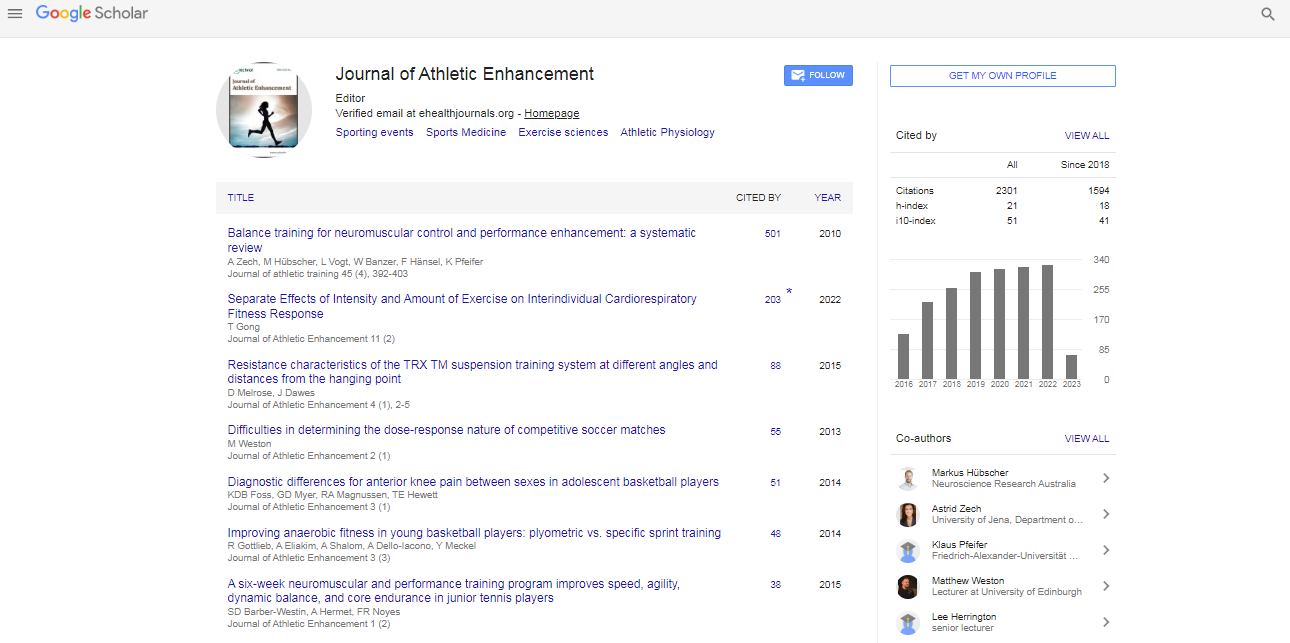Commentary, J Athl Enhanc Vol: 13 Issue: 4
Components of Physical Fitness and its Benefits in our Daily Life
Thoren Viklund*
Department of Sport and Exercise Science, Harbin Sport University, Harbin, China
*Corresponding Author: Thoren Viklund,
Department of Sport and Exercise
Science, Harbin Sport University, Harbin,
China;
E-mail: viklundthoren@edu.cn
Received date: 28 June, 2024, Manuscript No. JAE-24-144887;
Editor assigned date: 01 July, 2024, PreQC No. JAE-24-144887 (PQ);
Reviewed date: 15 July, 2024, QC No. JAE-24-144887;
Revised date: 22 July, 2024, Manuscript No. JAE-24-144887 (R);
Published date: 29 July, 2024, DOI: 10.4172/2324-9080.1000134
Citation: Viklund T (2024) Components of Physical Fitness and its Benefits in our Daily Life. J Athl Enhanc 13:4.
Description
Physical fitness is a state of health and well-being that enables individuals to perform daily activities efficiently and without undue fatigue. It encompasses a range of components, including cardiovascular endurance, muscular strength, flexibility and body composition. Engaging in regular physical activity is important for maintaining a healthy lifestyle and has profound effects on both physical and mental health.
Components of physical fitness
Cardiovascular endurance: This refers to the efficiency with which the heart, lungs and circulatory system work together to supply oxygen during sustained physical activity. Activities like running, swimming and cycling improve cardiovascular endurance, which is essential for overall health. A strong cardiovascular system helps in reducing the risk of chronic diseases such as heart disease, diabetes and hypertension.
Muscular strength: Muscular strength is the maximum amount of force that a muscle or group of muscles can generate. Strength training exercises, such as weight lifting and resistance exercises, are essential for building and maintaining muscle mass. Enhanced muscular strength supports better posture, joint health and overall functional capacity.
Flexibility: Flexibility refers to the range of motion available at a joint or group of joints. Regular stretching and flexibility exercises, like yoga or pilates, improve joint mobility and muscle elasticity. Good flexibility helps prevent injuries, reduces muscle tension and improves overall movement efficiency.
Body composition: Body composition is the ratio of fat to lean mass (muscles, bones, organs) in the body. Maintaining a healthy body composition is vital for overall health and wellness. A balanced diet and regular exercise help in achieving and sustaining an optimal body composition, reducing the risk of obesity and associated health problems.
Benefits of physical fitness
Improved health: Regular physical activity strengthens the cardiovascular system, boosts immune function and enhances metabolic health. It helps control weight, reduces the risk of chronic diseases and improves longevity. Engaging in fitness activities can also lower blood pressure, improve cholesterol levels and enhance bone density.
Enhanced mental health: Physical fitness is closely linked to mental well-being. Exercise stimulates the release of endorphins, often referred to as "feel-good" hormones, which can alleviate symptoms of depression and anxiety. Regular physical activity also enhances cognitive function, reduces stress and improves sleep quality.
Increased energy levels: Regular physical activity increases stamina and reduces fatigue. Engaging in consistent exercise improves overall energy levels by enhancing cardiovascular efficiency and muscle strength. Active individuals often report feeling more energetic and less tired throughout the day.
Better sleep: Exercise has been shown to regulate sleep patterns and improve the quality of sleep. Regular physical activity helps in falling asleep faster, staying asleep longer and achieving deeper, more restorative sleep. However, exercising too close to bedtime can have the opposite effect, so timing and intensity should be considered.
Enhanced quality of life: Regular physical activity contributes to a higher quality of life by improving physical and mental health. It enhances mobility, independence and functionality, allowing individuals to enjoy daily activities with greater ease and satisfaction. Exercise can also raise social connections, as group fitness activities and sports can provide opportunities for social interaction.
Physical fitness is a key of a healthy lifestyle, offering numerous benefits for both body and mind. By focusing on the key components of fitness cardiovascular endurance, muscular strength, flexibility and body composition and incorporating regular physical activity into daily life, individuals can improve their overall wellbeing, enhance their quality of life and achieve long-term health benefits. The journey to fitness is personal and unique, but the rewards of a healthier, more active lifestyle are universally valuable.
 Spanish
Spanish  Chinese
Chinese  Russian
Russian  German
German  French
French  Japanese
Japanese  Portuguese
Portuguese  Hindi
Hindi 
